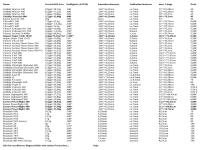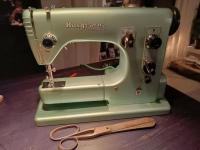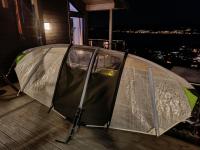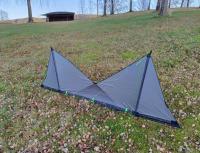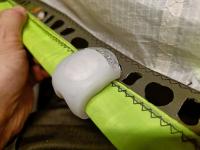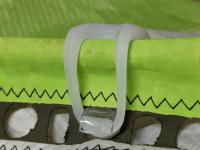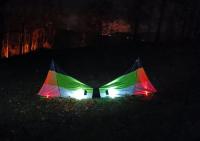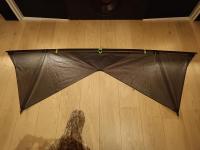
Fireliner
Members-
Posts
37 -
Joined
-
Last visited
-
Days Won
4
Fireliner last won the day on February 23 2022
Fireliner had the most liked content!
Profile Information
-
Favorite Kite(s)
quads
-
Flying Since
2019
-
Location
Norway
Recent Profile Visitors
The recent visitors block is disabled and is not being shown to other users.
Fireliner's Achievements

Newbie (1/7)
12
Reputation
-
-
I have researched a German forum and found info about, and users of carbon arrows, for kite use. Seems that a spine of 700 would correspond to skyshark P90. I think arrows with spine in the 250-700 range would cover most needs (Quad), given their dimensions match. Seems many actually do. Weights are comparable too.
-
I made crude spine testing rig and found my Crystal T2 rods to have spine at approximately 500 and Chrystal T3 a spine of 390. Gives me some indications.
-
-
Living in Norway and no suppliers of kite rods/spars. It is however possible to buy arrow-shafts wich seem to originate from the same producers. But what to look for when trying to find suitable rods? Weight obviously, and stiffness and/or flex. Arrow shafts seem to be categorized by "spine" Wich is a measurement of how much a rod bends for a central load. From Easton website: The spine rating of an arrow is simply a measurement of its stiffness. The same Easton arrow comes in a variety of stiffness: the lower the number, the stiffer the arrow. For example, a 330 arrow is stiffer than a 500 spine arrow. There are two kinds of spine (stick with us, we promise not to get too technical). There’s static spine, which is how an arrow reacts when an 880-gram (1.94 lbs.) weight is suspended from the center of the arrow. The arrow must be 29” in length and supported by two points, which are 28” apart. The number of inches the arrow deflects or bends X 1000 due to the weight is the spine size or measurement of an arrow. So, a 500 arrow bends .5-inches when the weight is applied. I suspect one might find equivalent arrowshafts to most of the commercially available "kite rods". Skysharks camo offerings seems to be a "arrowshaft" Now i need to find the proper "spine" for my kite rod substitutes. Anyone with knowledge wanting to share? I have read that a spine of 500 corresponds to a skyshark p200, and spine of 300 corresponds to about p300. I realize i need to build a spine measuring rig..
-
I would think you would be fine on hockey skates on ice of relatively good quality, the Nordics would be better on more uneven ice and possibly faster due to longer and flatter "steel". For proper icesailing tall 15-20cm skates with alpine skiboots seems preferred by the pros. I consider myself an happy amateur, and use what I'm most used to.
-
honestly i do not really know what the material in the clear panels are but i suspect it is some vinyl as it is not(to my eyes) a laminate. Most of the light coloured parts and also the clear parts of the wing is made out of parts from a older windsurfing sail "Hood Trilaminar kevlar". Black and fluorgreen wingtips is from an old traction kite. It's all about the project and of course the sailing fun.
-
Hi Michael. I have added some stiffness although not very much(roll wrapped some more fibreglass to masts) to the frame since the video was taken. I am still waiting for steady 10ms+(22mph+) winds, and of course the perfect ice (long stretch) that never shows up the same time as the wind.🤔 I still have som trimming options to explore with mast angle vs boom and sail tension. One of the benefits of low amounts of lift is the fact that I am able to force the sail into a more upright position(catching more wind). With apparent windspeed at speed i am still able to have enough lift to angle the skates(lean into the wind) This is hopefully only the first of several builds but time is limited so i think this would be the 2022 model. However I am still thinking of ways to improve and not afraid to modify, but would like to test in optimal conditions. I don't think weight would matter all that much speedwise but it would of course make the wing easier to manhandle trough tacks and gybes. Carbon would be stiffer and I think the wing could benefit from that, but at some point it would be so stiff that it would be gnarly in the gusts.
-
Due to really good ice conditions this winter I have been busy with a fun project. Having tried using wing(inflatable handheld traction device mostly used for foiling as in wingfoiling) as a propulsion device when ice skating, I could not let the thought that the thick leading edge of the inflatable wings were the limiting factor in top speed. So i buried myself in the shed and started building my own version. As usual no real plans to follow but somewhat inspired by kitewings ridgid frame wings. A week of late nights later and the wing was ready. About 3m2 sail area. Limited testing possibilities so far but the slim leading edge has a real advantage over the commercial inflatable wings when it comes to top speed but of course at a price of lower amounts of lift. However i like the fact that I could outrun wings with almost double the sail area when it comes to top speed. Some action up to around 50kmh 6ms windspeed gusting to 12. Soft slushy ice surface with pools of water on top. Nordic skates.
-
Felt really good in my novice hands but had a row of tree behind me that although they had lost their leaves made the already gusty inland wind more turbulent. A bit more responsive as you say than my first build (due to lighter weight?). Looking forward to test it in clean winds.
-
Ready for test flight. Traditional endcaps with shockcord on LE. Need some daylight, none after work..
-
With my limited skills i could agree that skills would matter most. I am still hopeful that I would be able to extend my lower end capability with approximately 90+grammes shaved of my first build. The biggest advantage of lighter weight rods would be increased flex in low wind conditions? with weight savings as a nice bonus? Of course, i like the feel of my vented kite over the full sail but sometimes the wind is too weak for me to keep both my heavy diy full sail and my vented freilein aloft.(without running) Being grounded is no fun😉 Lightest/flexiest spars i have are the freilein Chrystal T2. Also have T3 and skyshark p2x and p4x(travel length-40cm sections)
-
Did a basted bottom seam folded two times. Weight of kite with bridle currently at 189 grammes(Chrystal T2 spars) kite incl bridle w.o. Spars at 114 g including approx 10-15cm excess 3mm shock cord. Need to add knot cover for bungee at lower corners. Still contemplating the non bungee LE end caps. Would need to get some lighter weight(softer) spars. P90? Px1?
